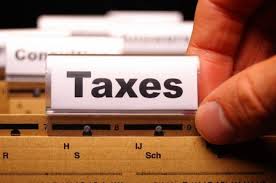Tax Time: Let’s Get Organized!
7 Feb
 Although the April 15th tax deadline is never really a surprise, it can have a way of sneaking up on people. Even if you’re the type of person that doesn’t really get going on your taxes until early April, you can still finish in time if you take time at the outset to get organized (bonus points if you put a system in place last year!)
Although the April 15th tax deadline is never really a surprise, it can have a way of sneaking up on people. Even if you’re the type of person that doesn’t really get going on your taxes until early April, you can still finish in time if you take time at the outset to get organized (bonus points if you put a system in place last year!)
Collect and Consolidate: “3 Piles”
The subject of organizing tax paperwork is a complex one, because everyone has a different situation:
- Are you an employer, an employee, self-employed, or some combination thereof?
- Do you need to factor in other things, such as charitable giving or investment-related income?
- Did you buy or sell a car or a house? Have a baby? Pay tuition?
Â
Complex and varied situations means there’s no one size fits all scheme. However your situation breaks down, whether your preparing your taxes on your own, or with the help of a professional, you want ALL of the relevant papers ready and organized. As mentioned last week, we’re huge fans of using durable plastic accordion folders to keep everything organized.
Regardless of the specifics of your situation, everyone’s tax prep comes down to 3 major categories: income, expenses/deductions, and investments. Getting organized (& maximizing your refund!) means no hunting for a lost receipt or W-2 once you sit down to file.
Pile 1: Income
For some people, this is as simple as a single W-2 from an employer. But as the number of sources of income increase, so does the paper trail. Make sure to collect in this folder all W-2’s (pro-tip: helps to keep December’s paystub too to verify your W-2 is correct!) and 1099’s. 1099’s come in many flavors, so if you have interest bearing accounts (1099-INT or 1099-DIV) or miscellaneous income (1099-MISC) you’ll want to collect those hear as well.
Pile 2: Expenses & Deductions (AKA: receipts, receipts, receipts!)
As a general rule, having printed statements (pro-tip: electronic statements, aka downloaded transaction lists, are more easily sortable & searchable) for all bank accounts and credit cards used throughout the year goes into pile 2. Also, bills that tie back to potential deductions- life events (house purchase, baby, etc.), medical/dental bills, charitable giving, etc. While you’re sorting, you can put all these into a single pile, but once you’ve collected the master list of receipts, you’ll want to run through them again and sort into sub-piles by their type. Bonus points if you create folders for next year’s receipts now so you’ll be more organized come next Winter 🙂
Pile 3: Investments
Only you know if this applies to you or not, but if you make regular investments, you may have some 1099-B forms, or if you’re involved in a partnership or LLC, you may have some K-1’s. Keep in mind, these forms all have a corresponding copy at the IRS, so you’ll want to make sure you account for them in your tax prep!
With your piles in order, you’re ready to move onto filing, and with any luck, shopping for some reward to honor the refund hopefully on it’s way! After you’ve filed your taxes, there are a couple more steps:
- You can shred pay stubs, once you know that they match up with the W2 issued by your employer.
- The rest of the materials that you’ve used to prepare your taxes should be consolidated and put in a safe but out of the way place for 7 years, should you ever be audited.
Â
While it’s still somewhat early, take the time to prepare mentally and get your papers in order for taxes. And if you haven’t been as proactive as you could have been this year, it’s the right time to start employing these strategies for next year, to make tax time as easy as possible.
(If you’re searching for a tax pro here’s some helpful tips)


No comments yet